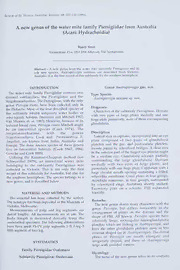
A NEW GENUS OF THE WATER MITE FAMILY PIERSIGIIDAE FROM AUSTRALIA (ACARI HYDRACHIDIA) PDF
Preview A NEW GENUS OF THE WATER MITE FAMILY PIERSIGIIDAE FROM AUSTRALIA (ACARI HYDRACHIDIA)
Records of the Western Australian Museum 19: 107-110 (1998). A new genus of the water mite family Piersigiidae from Australia (Acari: Hydrachnidia) Harry Smit Emmastraat 43-a, 1814 DM Alkmaar, The Netherlands Abstract - A new genus from the water mite subfamily Piersigiinae and its sole new species, AustrapiersiRia montana, are described from Victoria, Australia. It is the first record of this subfamily for the southern hemisphere. INTRODUCTION Genus Atistrapiersigia gen. nov. The water mite family Piersigiidae contains tw'o Type Species distinct subfamilies, the Piersigiinae and the Austrapiersigia monimia sp. nov. Stygolimnocharinae. The Piersigiinae, with the only genus PiersiRia Protz, have been collected only in Diagnosis the Holarctic. Most of the four described species of Characters of the subfamily Piersigiinae. Dorsum this subfamily inhabit temporary water bodies or with two pairs of large plates medially and one semi-aquatic habitats (Imamura and Mitchell 1967; large plate posteriorly, none of them encompassing Van Maanen et. al. 1997). However, because of its glandularia. reduced lateral eyes, Piersigia criista Mitchell might be an interstitial species (Cook 1974). The Stygolimnocharinae, with the genera Description Stygolitnnocliares Cook and Parawandesia E. Lateral eyes in capsules, incorporated into an eye Angelier, are known from India, Australia and plate composed of tw'o pairs of glandularia Europe. The three know'n species of these genera platelets and the pre- and postocularia platelets, live in interstitial habitats (Cook 1967, 1986; loosely joiiied by sderotized bridges. A clear area in the anterior part of the largest eye platelet might Gerecke and Cook 1995). be a median eye. Glandularia sclerites partially Utilising the Karaman-Chappuis method (see Schwoerbel 1979), an interstitial water mite surrounding the large glandularia. Dorsum belonging to the subfamily Piersigiinae was medially w'ith two pairs of large plates, and posteriorly with one large plate. Capitulum with a collected in Victoria. This is not only the first large circular mouth opening containing a frilled, record of this subfamily for Australia, but also for w'heel-like membrane. Coxal plates in four groups. the southern hemisphere. Tlie species belongs to a Acetabula numerous, in four groups, surrounded new' genus, and is described below. by sderotized rings. Acetabula shortly stalked. Excretory pore on a sclerite. PHI expanded MATERIAL AND METHODS laterally. The material has been collected by the author. Remarks The holotype has been deposited in the Museum of The new genus shares many characters with the Victoria, Melbourne. genus Piersigia, but differs noticeably in the Measurements of palp and leg segments are arrangement of plates on the dorsum and the dorsal lengths. All measurements are in pm. The shape of Pill. All knowm Piersigia species have body length is measured dorsally from the relatively large, rectangular lateroglandularia unmounted specimen. The following abbreviations platelets which are lacking in Atistrapiersigia, and have been used: PI-PV palp segments 1-5; I-leg-5 have the other glandularia platelets more or less fifth segment of first leg. cre.scent shaped (as in Austrapiersigia). The dorsal plates of Piersigia are small, elongate and irregularly shaped, and those of Austrapiersiga SYSTEMATICS large with rounded corners. Family Piersigiidae Oudemans Etymology Subfamily Piersigiinae Oudemans The name of the new genus refers to its southern H. Smit 108 Figures 1, 2 Aiiftrapicrfij^ia montaiia sp. niiv., holotype 9: 1, dorsal view; 2, ventral view. Scale line 200 pm. A new genus of Piersigiidae 109 Figures 3-5 Auslrapiersigia montam sp. nov., holotype $: 3, lateral view of PlI-PV; A, dorsal view of PII-PIII; 5, I- leg-5-6. Scale lines 50 pm. 110 H. Smit occurrence and the similarity with the genus Etymology Piersigia. The name refers to its occurrence in the mountains of the Dividing Range. Austrapiersigia montima sp. nov. Figures 1-5 ACKNOWLEDGEMENTS Material Examined 1 am indebted to the Department of Natural Resources and Environment (Melbourne) for their Holotypc permission to collect water mites in the national 9, interstitial of unnamed creek. The Tong Plain parks of Victoria and to Dr M.S. Harv'cy for his (± 1300 m above sea level), Mt Buffalo National comment on a first draft of this paper. Park, Victoria, Australia, 10 October 1997. Diagnosis REFERENCES As for genus. Cook, D.R. (1967). Water mites from India. Memoirs of the American Entomological Institute 9: 1-411. Description Cook, D.R. (1974). Water mite genera and subgenera. Memoirs of the Entomological Institute 21: 1-860. Female Cook, D.R. (1986). Water mites from Australia. Memoirs Body 1319 long and 980 wide. Integument soft, of the American Entomological Institute 40: 1-568. papillate, body colour orange. Posterior part of eye Gerecke, R. and Cook, D.R. (1995). Morphology, plate rounded, 242 long. This large plate with a systematic position and zoogeography of clear area which might be a median eye. Dorsum Paraivandesia chappuisi E. Angelier, 1951 (Acari, medially with two pairs of large plates (Figure 1), Actinedida, Piersigiidae). Zoologischer Anzeiger 234 125-131. the anterior 281 in width, the posterior 340-369 in width. Posterior plate of dorsum 582 in width. Imamura, T. and R. .Mitchell (1967). The ecology and life history of the water mite, Piersigia limnophila Protz. Coxal plates in four group.s, covered with many Annotationes Zoologicae japonensis 40; 37-44. fine setae. Genital field 218 in length. Acetabula Schwoerbel, J. (1979). Methoden der Hydrohiologie. shortly stalked, located in four groups (Figure 2), Siijhoasserbiologie. Second edition. G. Fisher, the anterior groups more elongated compared to Stuttgart. posterior groups. Each group has 21-22 acetabula. Van Maanen, B., Tempelman, D. and Smit, H. (1997). Lengths of PI-PV: 32, 94, 98, 70, 36. PHI with a Piersigia koenikei new for the Dutch fauna and new group of setae at anteroventral comer (Figure 3), Dutch records of Piersigia intermedia and Vietsia PHI greatly expanded laterally (Figure 4). Lengths scutata (Acari: llydrachnellae). Entomologische of l-leg-4-6: 115, 156, 173. Lengths of IV-leg—4-6; Berichten, Amsterdam 57; 113-118. 165, 194, 223. Legs with numerous stout, serrated setae (Figure 5); swimming setae absent, claws Manuscript received 1 December 1997; accepted 76 March simple. 1998.
